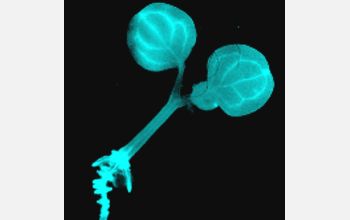Multimedia Gallery
Bioluminescent Plant Arabidopsis thaliana
Bioluminescent plant Arabidopsis thaliana. Bioluminescent organisms ranging from plants to flies (Drosophila) are powerful tools for studying circadian rhythms--the daily rhythmic activity cycle, based on 24-hour intervals, that is exhibited by many organisms. [See related image Here.]
More about this Image
Steve A. Kay, a National Science Foundation (NSF)-supported researcher from the Scripps Research Institute, is studying the circadian biology of a wide range of organisms--from humans to fruit flies to plants.
Bioluminescence from a firefly is created by an enzymatic reaction that takes place in its abdomen. The enzyme responsible for this light-producing reaction is called luciferase. Luciferase uses oxygen, ATP and luciferin to generate light. The firefly's DNA contains the genetic information (gene) for the enzyme luciferase. The luciferase gene is the blueprint that an organism uses to make the luciferase protein. The DNA encoding the luciferase gene can be introduced into the genetic makeup of the other organisms. For example, Kay has introduced the gene into fruit flies, plants and bacteria. Once these genetically altered organisms contain the gene for luciferase, they can glow in the dark.
Organisms regulate their behavior and metabolism in a circadian (or 24 hour) cycle. Examples of this are a human's sleep/wake cycle or a flower's open/close cycle. The cycles are controlled by an internal circadian clock that resides within our cells. Kay's laboratory utilizes luciferase bioluminescence technology to observe what happens inside these clocks. Scientists introduce the Luciferase gene into fruit flies and plants under the direct control of the circadian clock and then, using ultra-sensitive cameras, the team follows the circadian pattern of bioluminescence over time.
All clocks must be set to the correct time. Plants use light/dark cycles to set their circadian clocks. By using luciferase bioluminescence to monitor the circadian rhythm in plants, Scripps researchers have been able to identify which photoreceptor molecules (phytochrome and cryptochrome) are involved in setting the clock. Using information about the photoreceptors responsible for setting the clock in plants we have found a similar photoreceptor that is involved in the clock in fruit flies and mammals.
Understanding how light resets the clock is a key piece of information for developing strategies to overcome jetlag and problems associated with shift work. Understanding the relationship between light and the clock in plants will allow us to manipulate developmental events such as flowering time so that we can grow crops all year round.
This work was supported by NSF grant MCB 96-96255. The support from this grant allowed Kay to develop a sophisticated assay for defining which photoreceptors are important to signaling the circadian clock in Arabidopsis. (Year of image: 1999)
Credit: Steve A. Kay, The Scripps Research Institute
Images and other media in the National Science Foundation Multimedia Gallery are available for use in print and electronic material by NSF employees, members of the media, university staff, teachers and the general public. All media in the gallery are intended for personal, educational and nonprofit/non-commercial use only.
Images credited to the National Science Foundation, a federal agency, are in the public domain. The images were created by employees of the United States Government as part of their official duties or prepared by contractors as "works for hire" for NSF. You may freely use NSF-credited images and, at your discretion, credit NSF with a "Courtesy: National Science Foundation" notation.
Additional information about general usage can be found in Conditions.
Also Available:
Download the high-resolution TIFF version of the image. (4.3 MB)
Use your mouse to right-click (Mac users may need to Ctrl-click) the link above and choose the option that will save the file or target to your computer.



